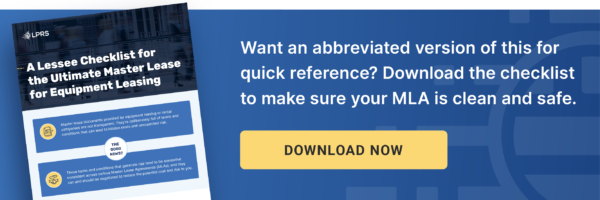Uncovering Hidden Fees in Your Equipment Leasing MLA
If you signed a Master Lease Agreement (MLA) with an equipment leasing or rental company, there’s a chance you’re paying more than you bargained for. Typically, these types of MLAs are full of carefully crafted language that can leave you susceptible to hidden costs and unexpected risk.
Thankfully, the problematic language in leasing agreements tends to be the same across various elements of MLAs, which means you can identify areas of risk and negotiate to reduce the overall cost.
Here we’ve identified the key areas of your MLA you should review closer, and provided terms to look out for and best practices on how to improve transparency and reduce risk and cost.
Notice Provisions
Why You Should Pay Attention to Notice Provisions in Your Master Lease Agreement
Notice Provisions: Notice provisions occur at various points in a master lease. They typically focus on requiring the lessee to provide the lessor with a notice of an event or of the lessee’s intentions regarding equipment disposition at end of lease.
Best practice is to both:
- shorten the time period required by the lessor to something which reasonably matches lessee behavior; and
- require the lessor to provide the lessee with notice of certain events such as end of initial lease term nearing or payment due date, etc.
Notice Form: The form of notice is a critical element of the notice provision. Many leases require lessees to send notice, certified mail only accepted, to a specific address or person.
Best practice: The notice form terms should be negotiated to accept emails or other forms of communication, such as asset management software.
Notice Windows: Notice provisions can sometimes require windows of time during which notice can only be provided. For example, “not more than 180 days but not less than 90 days prior to end of lease.” Such notice windows create an obligation which can be hard to manage and therefore should be avoided as best practice.
MLAs can be complex and overwhelming to understand and negotiate. Improving the notice element is only one step of the process.
Interim Rent
Overlooking Interim Rent in Your Master Lease Agreement Can Cost You
Interim rent is the per diem charge for any delivered and accepted equipment prior to the commencement of a lease schedule. Interim rent, as a concept, is a reasonable charge. As the equipment is received, and the lessor pays the equipment vendor for such equipment, the lessee pays a pro-rata fee for use of the equipment received until the requirements of the lease documentation have been met and the regular lease payments begin. However, these interim rent payments do not reduce the regular term rent commitment. They are simply additional payments made to compensate the lessor for use of the equipment prior to the lease proper beginning. Interim rent is typically overlooked in the initial lease vs. buy financial analysis, and payments can go on for months, quarters, and sometimes years if the final few pieces of equipment are not received or the lease terms require special notice to begin regular term. When not properly managed, Interim rent can be one of the costliest elements of equipment leasing. A best practice is to make sure that interim rent is clearly defined and capped so that an accurate prediction can be included in the initial financial analysis.
MLAs can be complex and overwhelming to understand and negotiate. Capping your interim rent exposure is only one step of the process.
Best practice is to make sure that interim rent is clearly defined and capped so that an accurate prediction can be included in the initial financial analysis.
End-of-Term Options
How to Negotiate Favorable End-of-Term Options in Your Master Lease Agreement
At the end of lease, you should have several options, including:
- Return any or all of the equipment
- Renew the lease at a lower cost for a specific time period
- Extend the lease month to month
- Buyout the equipment at a reasonable Fair Market Value (FMV)
The devil is in the details in terms of how these elements are structured. When it comes to equipment return, partial return with pro-rata reduction in payments should be allowed. Beware of the requirement to return “all but not less than all” equipment, which is a common default option in many MLAs. This can lead to full rent extensions being paid for extended periods. Instead, the contract should allow to return “any or all” equipment. Additionally, like-for-like return is another best practice, which allows for serial number substitution.
If you need the equipment for an extra period of time but still want the ability to return it at the end of that additional period, a lease renewal may be the best option. The rent payments for the renewal period should be based on the FMV of the equipment at that time, thus resulting in a lower rental payment. Extensions should be month-to-month as opposed to quarterly or annually, and should be capped in duration.
Lastly, an option for a full or partial buyout of the equipment should be included, as well as a reasonable FMV definition. If both parties disagree on the FMV estimates, a FMV dispute resolution process should also be well defined and include time limits to restrict extension payments.
MLAs can be complex and overwhelming to understand and negotiate. Capping your extension periods and giving you more options at the end of lease is only one step of the process.
Best practices include:
- allow to return “any or all” equipment
- Like-for-like return, which allows for serial number substitution
- Lease renewals should be an option if you need the equipment for an additional period of time but still want the ability to return it at the end of that additional period
- The rent for the renewal period should be based on the FMV of the equipment at that time, thus resulting in a lower rental payment
- Extensions should be month-to-month as opposed to quarterly or annually, and should be capped in duration
- An option for a full or partial buyout with a reasonable FMV definition of the equipment should be included
- If both parties disagree on the FMV estimates, a dispute resolution process should be well defined and include time limits to restrict extension payments
Default Section
Do You Understand the Hidden Risk in the Default Section of Your Master Lease Agreement?
A common default term, such as paying any invoice 10 days past its due date, can make it very easy for the lessee to go into default, and the remedies are commonly draconian. Often, for late payment, the lessor is not required to inform the lessee of the default event, so lessees are frequently in default on lease transactions but do not know it.
Another important default term is the event of cross-default, which happens if lessee defaults under any other existing agreement, then lessee will automatically be in default with the current lessor. Beware of such clauses and negotiate the terms to only include the lessor and its affiliates.
MLAs can be complex and overwhelming to understand and negotiate. Most organizations look at default as an unlikely event. As a result, default triggers and remedies contract terms do not get the attention they deserve. And even if you negotiate more favorable default terms for your organization, this is only one step of the process to get a clean contract agreement.
Best practice is to write into the contract that your lessor is required to notify you of a default payment and to agree on a reasonable default consequence.
General Provisions
How To Improve General Provisions in Your Master Lease Agreement
Damage / Return Charges
Damage charges for returned equipment at end of lease can have a material impact on the lessor overall profitability. Many large vendors and their captive leasing arms charge higher and more frequent damage charges than banks or independent leasing companies. Banks and independent lessors typically outsource return processing and frequently get flat rates for returned equipment. As a result, damage charges are lower and less frequent and contribute less to overall profitability for these lessors. Damages can be costly and hard to track.The best practice is to define the damage charges in advance on a pricing chart which lays out the cost of each charge for each category.
Best practice is to define the damage charges in advance on a pricing chart which lays out the cost of each charge for each category.
Casualty Loss and Casualty Loss Value
Casualty loss definition and the related values can create a material exposure for the lessee. The lessee should have the right to repair or replace lost or damaged equipment and the time to cure such a situation and related notice should be sufficient to complete the action. The value to be paid for lost or destroyed equipment should be limited and not include a laundry list of various charges as is all too common.
Best practice: Clearly define the casualty loss definition and the related values as to not create a material exposure.
State of Law
As a lessee, you should always request that all lease documents are governed by the state of your domicile.
Customization of Asset Types
If your organization leases different types of equipment (IT, office furniture, medical equipment, etc.), you should ensure that the MLA terms allow for customization of these different asset types, when it comes to return requirements, like-for-like exchange, maintenance, etc.
Meet LPRS
At LPRS, our only goal is to help you, the lessee, avoid and prevent risk in your contracts so you’re never paying more than you should. Each element of the MLA should cap your exposure and ensure that you can reasonably achieve any requirements, and at the same time eliminate any significant downstream leverage for the lessor.

